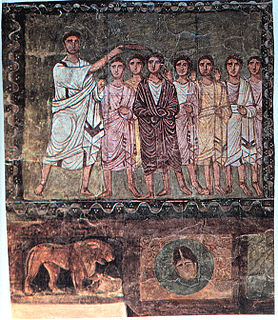
In Abrahamic religions, a messiah or messias is a saviour or liberator of a group of people. The concepts of mashiach, messianism, and of a Messianic Age originated in Judaism, and in the Hebrew Bible, in which a mashiach is a king or High Priest traditionally anointed with holy anointing oil.
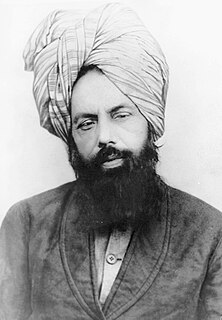
Mirzā Ghulām Ahmad was an Indian religious leader and the founder of the Ahmadiyya movement in Islam. He claimed to have been divinely appointed as the promised Messiah and Mahdi—which is the metaphorical second-coming of Jesus (mathīl-iʿIsā), in fulfillment of Islam's latter day prophecies, as well as the Mujaddid of the 14th Islamic century.
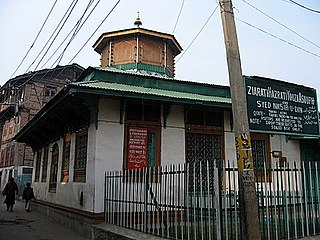
The Ahmadiyya branch portrays Jesus as a human mortal man and a prophet of God, born to the virgin Mary. Jesus is understood to have survived the crucifixion based on the account of the gospels, hadith, and the Quran. Having delivered his message to the Israelites in Judea, Jesus is understood to have emigrated eastward to escape persecution from Judea and to have further spread his message to the Lost Tribes of Israel.

The Lahore Ahmadiyya Movement for the Propagation of Islam, is a separatist group within the Ahmadiyya movement that formed in 1914 as a result of ideological and administrative differences following the demise of Hakim Nur-ud-Din, the first Caliph after Mirza Ghulam Ahmad. Members of the Lahore Ahmadiyya movement are referred to by the majority group as ghayr mubāyi'īn and are also known colloquially as Lahori Ahmadis.

The Ahmadiyya Caliphate is a non-political caliphate established on May 27, 1908 following the death of Mirza Ghulam Ahmad, the founder of the Ahmadiyya Muslim Community, who claimed to be the promised Messiah and Mahdi, the expected redeemer awaited by Muslims. It is believed by Ahmadis to be the re-establishment of the Rashidun Caliphate that commenced following the death of the Islamic prophet Muhammad. The caliphs are entitled Khalīfatul Masīh, sometimes simply referred to as Khalifa. The caliph is the elected spiritual and organizational leader of the worldwide Ahmadiyya Muslim Community and is the successor of Ghulam Ahmad. He is believed by the Community to be divinely ordained and is also referred to by its members as Amir al-Mu'minin and Imam Jama'at. The 5th and current Caliph of the Messiah of the Ahmadiyya Community is Mirza Masroor Ahmad.
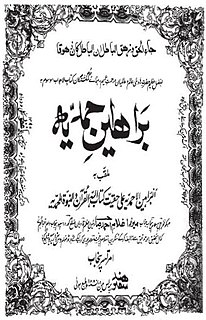
al-Barāhīn al-Ahmadīyyah 'alā Haqīqatu KitābAllāh al-Qur'ān wa'n-Nabūwwatu al-Muhammadīyyah is a five-part book written by Mirza Ghulam Ahmad, the founder of the Ahmadiyya Movement. The first two parts were published in 1880 CE, the third volume was published in 1882, the fourth volume in 1884 and the fifth volume in 1905. In writing the book, Ghulam Ahmad sought to rejuvenate Islam by arguing for the validity of its principles and vindicating its teachings in response to Christian and Hindu polemics against Islam as well as atheistic philosophies. In this context, a significant portion of the subject matter of the book is dedicated to the defence of Islam as a whole against the criticism of Muhammad, the Qur'an and Islam that was raised in the 18th and 19th centuries predominantly by Christian missionaries and Hindu revivalists.
Dajjal is an evil figure in Islamic eschatology. He is said to have come from several different locations, but generally from the East, usually between Syria and Iraq.

Mirza Basheer-ud-Din Mahmood Ahmad, was the second caliph, leader of the worldwide Ahmadiyya Muslim Community and the eldest son of Mirza Ghulam Ahmad from his second wife, Nusrat Jahan Begum. He was elected as the second successor of Mirza Ghulam Ahmad on 14 March 1914 at the age of 25, the day after the death of his predecessor Hakim Nur-ud-Din.

The view on the Prophets of God in Ahmadiyya theology differs significantly from Mainstream Islam. The main difference centres on the Quranic term Khatam an-Nabiyyin with reference to Muhammad which is understood by Ahmadis in terms of perfection and testification of prophethood instead of chronological finality. Accordingly, Muhammad is held to be the last prophet to deliver a religious law to humanity in the form of the Quran whose teachings embody a perfected and universal message. Although, in principle, prophets can appear within Islam but they must be non-lawbearing prophets dependent upon the sharia of Muhammad. Their prophethood is reflective of that of Muhammad, that is, within his Seal; and their role is merely that of reviving and purifying the faith. They cannot be prophets in their own right and cannot change, add to or subtract from the religious law of Islam. As such, Ahmadis, regard their founder Mirza Ghulam Ahmad as a prophet who appeared as the promised Messiah and Mahdi in accordance with Islam's eschatological prophecies. In contrast to mainstream Muslims who believe Jesus to be still alive and one who would return himself towards the end of time, Ahmadis believe Jesus to have died a natural death and view the coming of such an independent, Israelite prophet to amount to breaking the Seal of Prophethood.

Ahmadiyya, officially the Ahmadiyya Muslim Community or the Ahmadiyya Muslim Jama'at, is an Islamic revival or messianic movement originating in Punjab, British India, in the late 19th century. It was founded by Mirza Ghulam Ahmad (1835–1908), who claimed to have been divinely appointed as both the Promised Mahdi and Messiah expected by Muslims to appear towards the end times and bring about, by peaceful means, the final triumph of Islam; as well as to embody, in this capacity, the expected eschatological figure of other major religious traditions. Adherents of the Ahmadiyya—a term adopted expressly in reference to Muhammad's alternative name Aḥmad—are known as Ahmadi Muslims or simply Ahmadis.

The British Government and Jihad is a book written in 1900 by Mirza Ghulam Ahmad, the founder of the Ahmadiyya movement in Islam. An alternative title is the True Meaning of Jihad. It was published on 22 May 1900 and was translated into English in 2006, by Islam International Publications.

Prophets in Islam are individuals to serve as examples of ideal human behavior and to spread God's message on Earth. Some prophets are categorized as messengers, those who transmit divine revelation, most of them through the interaction of an angel. Muslims believe that many prophets existed, including many not mentioned in the Quran. The Quran states: "There is a Messenger for every community". Belief in the Islamic prophets is one of the six articles of the Islamic faith.

The Promised Reformer Day is celebrated by Ahmadi Muslims annually on 20 February in remembrance of the prophecy concerning the birth of an "illustrious son" to Mirza Ghulam Ahmad whom the Ahmadis regard as the Promised Messiah and Mahdi, and its fulfilment in the person of Mirza Bashir-ud-Din Mahmud Ahmad, the second Caliph of the Ahmadiyya Muslim Community. It is not a celebration of Mahmud Ahmad's birth which occurred on 12 January, but rather the commemoration of the prophecy and its fulfilment in his person.
Ahmadiyya is the third most popular branch of Islam which originated from India and spread all across the world. It was founded by Mirza Ghulam Ahmad in 1889. The total population of the community is estimated to be between 10–15 million, with main concentrations in South Asia. For a history timeline see Timeline of Ahmadiyya history.

The timeline of Ahmadiyya history began in 1889 when the Ahmadiyya Muslim Community was established in Qadian, a village of India. It is now a worldwide community consisting of members from over 200 nations.

Ahmadiyya in Israel is a small community in Israel. The Community was first established in the region in the 1920s, in what was then the British Mandate of Palestine. Israel is the only country in the Middle East where Ahmadis can openly practice their faith. As such, Kababir, a neighbourhood on Mount Carmel in Haifa, Israel, acts as the Middle East headquarters of the Community. It is unknown how many Israeli Ahmadis there are, although it is estimated there are about 2,200 Ahmadis in Kababir alone.
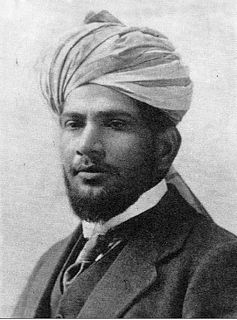
Chaudhry Fateh Muhammad Sial (1887–1960) was born in a prominent feudal landowning family. He was a companion of Mirza Ghulam Ahmad and the first Ahmadi missionary sent from India, under the leadership of Hakeem Noor-ud-Din, the first Khalifa of the Ahmadiyya movement. In 1913, Mirza Basheer-ud-Din Mahmood Ahmad asked for volunteers to serve as Ahmadi Muslim missionaries in England. Sial volunteered and travelled to England on June 22, 1913 and arrived the following month. There he served twice as a missionary. He earned an MA in Arabic from the Aligarh Muslim University.

Qazi Muhammad Yousaf was a companion of Mirza Ghulam Ahmad. He was regional head Amir of North West Frontier chapter of the Ahmadiyya Community.

The Ahmadiyya branch in Islam has relationships with a number of other religions. Ahmadiyya consider themselves to be Muslim, but are not regarded as Muslim by mainstream Islam. The mainstream Muslims branches call the Ahmadiyya branch with the religious slur "Qadianis". and their beliefs as "Qadianism" which is named after Qadian, the small town in the Gurdaspur district of India's Punjab region where the founder of Ahmadiyya Ghulām Ahmad was born. The Ahmadi Musliims dislike this term, because it has derogatory connotations and because they prefer to differentiate their two movements.

Ahmadiyya is a persecuted branch of Islam in Saudi Arabia. Although there are many foreign workers and Saudi citizens belonging to the Ahmadiyya movement in Saudi Arabia, Ahmadis are officially banned from entering the country and from performing the pilgrimage to Mecca and Medina. This has led to criticisms from multiple human rights organizations.












